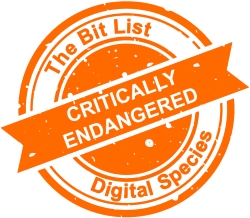Digital Archives of Community Groups
 |
||
|
Digital materials including ephemera, correspondence and campaign materials created as a by-product of small scale or ad-hoc community action groups. |
||
|
Digital Species: Community Archives |
Trend in 2023:
|
Consensus Decision |
|
Added to List: 2019 |
Trend in 2024:
|
Previously: Critically Endangered |
|
Imminence of Action Action is recommended within three years, detailed assessment within one year. |
Significance of Loss The loss of tools, data or services within this group would impact on people and sectors around the world. |
Effort to Preserve | Inevitability It would require a major effort to prevent or reduce losses in this group, possibly requiring the development of new preservation tools or techniques. |
|
Examples Archives of smaller and ad-hoc political and campaigning organizations; environmental protests; sports clubs; smaller religious groups; amateur music or drama; fan groups. |
||
|
‘Practically Extinct’ in the Presence of Aggravating Conditions Poor documentation; lack of replication; lack of continuity funding; lack of residual mechanism; dependence on a small number of volunteers, lack of preservation mandate; lack of preservation thinking at the outset; conflation of backup with preservation; conflation of access and preservation; inaccessible to web archiving; dependence on social media providers; distrust of ‘official’ agencies; uncertainty over IPR or the presence of orphaned works. |
||
|
‘Endangered’ in the Presence of Good Practice Residual archive with residual funding able to receive and support collections; active user community; intellectual property managed to enable preservation. |
||
|
2023 Review The Jury created this entry in 2019 as a subset of ‘Community Archives and Community-Generated Content’ which was split into two entries to provide greater specificity in recommendations for approaching the preservation of created as a by-product of small scale or ad-hoc community action groups (versus digital materials generated for significant purpose of a community initiative). The 2020 Jury identified a 2020 trend towards greater risk based on community groups such as sports clubs, religious communities, arts and political groups, often relying on volunteer effort, being unable to meet for extended periods in 2020. Moreover, the local community centres, clubs or places of worship on which they depend had closed, in some cases for good. This trend continued for 2021; the 2021 Jury commented that much of the content in community archives has easily preservable content, but resources are not directed towards them, basic digital preservation practices are not well embedded amongst the general population, and selective approaches are needed to get a handle on the situation and to find the resources to do the work. The 2023 Council agreed with the classification of Critically Endangered. with the overall risks remaining on the same basis as before (‘No change’ to the 2023 trend). However, they also noted an increase in the significance of loss due to the fact that community heritage tends to be part of wider conversations within the international landscape. |
||
|
2024 Interim Review The 2024 Council agreed these risks remain on the same basis as before, with no significant trend towards even greater or reduced risk (‘No change’ to trend). |
||
|
Additional Comments Typically, born-digital material is more at risk as community groups may not know about the risk of loss. Many are unaware of digital preservation terminology. It is the ad-hoc nature of these groups and projects which is of great concern. There is a significant need to raise awareness and provide a ‘home’ but also to do so with sufficient sensitivity so as to ensure community groups remain in control of their own material. Communities who live in rural and remote areas may have a lack of access to services such as broadband connectivity, which is a well-reported issue and is often referred to as the ‘digital divide’. Inadequate internet connectivity would diminish the capacity for these communities to access digital preservation solutions, such as cloud storage for digital assets. This is especially prevalent with personal photos and videos on mobile phones as possession of a mobile phone does not necessarily mean the user has adequate internet connectivity to be able to upload videos to web-based platforms. AI could potentially be used to assist with easy access to simple, succinct explanations and principles of digital preservation and archiving solutions which would give these communities a wider understanding of the work being done and empower them to be able to do minimum digital preservation themselves. See also:
|
||









































































































































